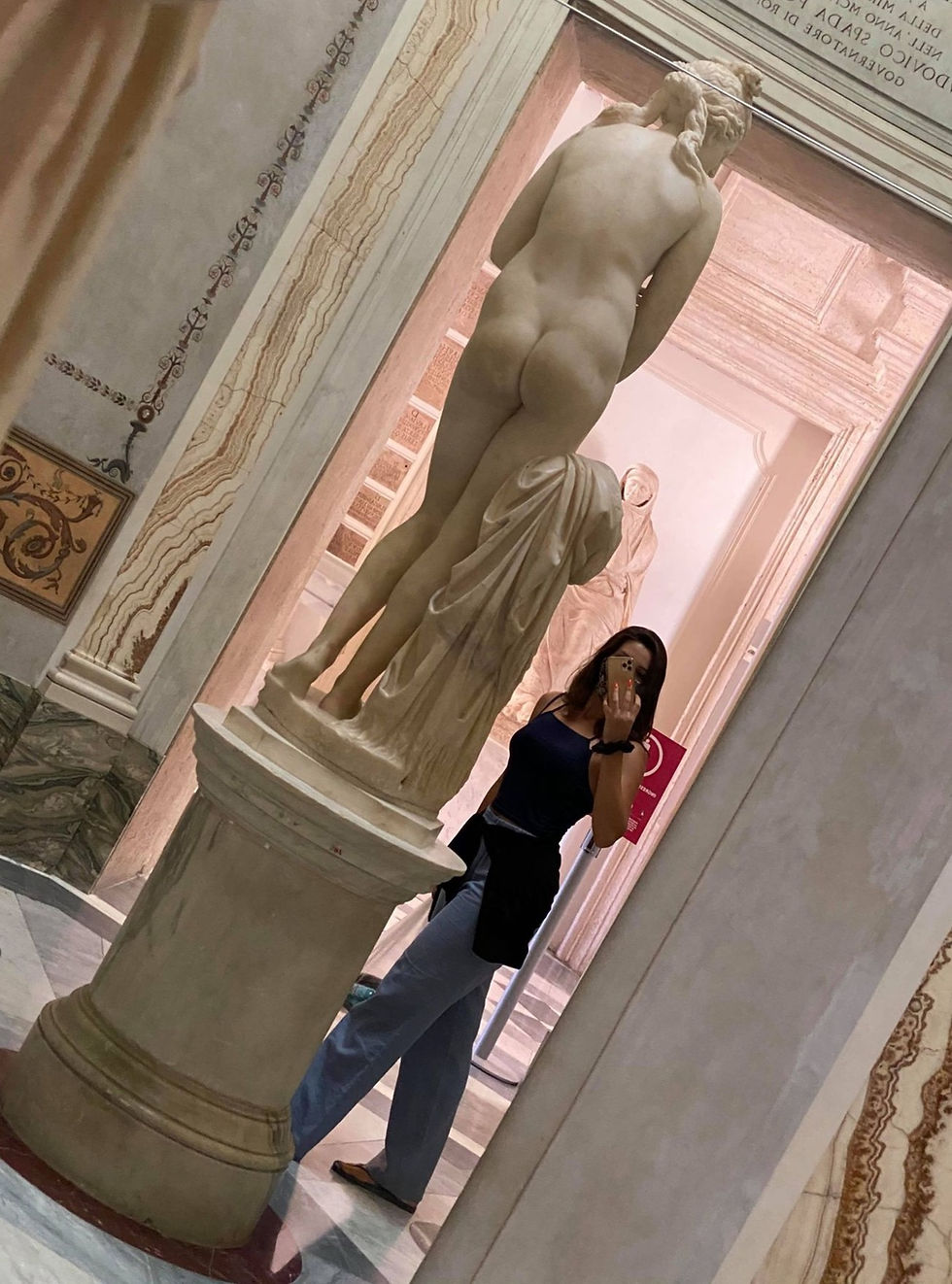The Capitoline Venus: False Modesty?
- Tatyana

- Sep 4, 2020
- 3 min read
Updated: Dec 19, 2022
The Capitoline Venus depicts Venus (the Roman goddess of beauty, love and sexuality) attempting to cover her nakedness after emerging from her bath.
Venus stands in the classical contrapposto position; all her weight is on her left leg, while her right leg is bent. This pose both imbues her body with a graceful curve, and accentuates her vulnerability. She is, after all, standing fully nude, and her naked body is visible to us without her consent. Her hunched shoulders and the turn of her head emphasise Venus’s powerlessness and her attempt to shield herself from our gaze. Her pose makes us, the viewer, feel like a voyeur. We are made to feel as if we have intruded upon the goddess in a moment of vulnerability.
And yet, although she does attempt to cover her breasts and her pubic area, it is clear that Venus’s naked body is very much on show for the viewer. Her soft and fleshy skin, which has been rendered by the expert carving of the marble, is on full display for us to admire. Her arms do not fully conceal her breasts and groin area. In fact, you could even argue that Venus’s attempt to conceal herself is half-hearted, and that her pose can be read as one of false modesty. Indeed, her arms ironically draw attention to her breasts and her groin, thus accentuating, rather than concealing, her nakedness.
The water vase covered with a cloth to her right, acts as a support system. The material, which has been draped over the vase, also reinforces the idea of covering and uncovering, which is the central theme of this sculpture. The water vase also alludes to the theme of bathing, or could be seen as referencing the fact that Venus herself was born from the sea.
This slightly larger than life marble sculpture was discovered in 1666-1670 near the Basilica of San Vitale in Rome. It was found pretty much intact expect for its nose, a few fingers, and one hand, which has since been reattached.
This sculpture dates to the 2nd century CE. It is an ancient Roman imitation of an ancient late Hellenistic sculpture which ultimately derives from an ancient Greek sculpture from the 4th century BC known as the Aphrodite of Knidos (c.350 BC). This original sculpture of Aphrodite (Aphrodite is the Greek name for Venus) was carved by the famous Greek sculptor Praxiteles. His Aphrodite of Knidos was the first life-sized nude sculpture of a female to ever have been created, thus forever changing the course of art. His original Aphrodite only used one hand to cover her only her groin (leaving her breasts exposed); whereas the Capitoline Venus uses both her arms to attempt to cover both her breasts and her groin. The original Aphrodite of Knidos unfortunately perished in a fire in Constantinople (now Istanbul) in the year 475 AD, but many copies of it were made before it was destroyed (including the 2nd/3rd century BC sculpture that the Capitoline Venus was modelled after).
Today, the Capitoline Venus is known as one of many Venus Pudicas, (Modest Venuses); a type of Venus sculpture which features the goddess of love attempting to cover her nude form in the context of bathing.
In the Capitoline Museums, the sculpture is depicted in a rotunda of its own, therefore allowing you to experience the sculpture in the round, much like it was meant to be appreciated in antiquity.
In ancient times, such sculptures of the goddess of love incited very intense reactions from those observing her. The ancient author and philosopher Pliny the Elder recounts stories of young men mistaking Praxiteles’s original sculpture for real flesh and blood, and falling in love with her. He gives a sense of the intense sexual desire that such sculptures provoked from their audiences.
Head over to the Capitoline Museums to see this work of art, one of Rome’s best preserved ancient sculptures, and pay attention to how it makes you feel. Will you feel entranced by Venus’s beauty? Or will you feel like an intruder? A voyeur?
FYI: Bear in mind that this sculpture was most likely originally painted, so it would have looked even more lifelike than it does today.

Bibliography:
A Masterpiece from the Capitoline Museum, Rome, The Capitoline Venus. The National Gallery, 2011, https://www.nga.gov/content/dam/ngaweb/exhibitions/pdfs/venus.pdf
Amanda Claridge. Rome: An Oxford Archaeological Guide. Second edition. Oxford Archaeological Guides. Oxford: Oxford University Press, 2010.
Capitoline Aphrodite. Museum of Classical Archaeological Databases. The University of Cambridge. https://museum.classics.cam.ac.uk/collections/casts/capitoline-aphrodite
Rebecca Williams. "The Troubling Aspects of the Capitoline Venus." In Media Res, 2018, https://medium.com/in-medias-res/the-troubling-aspects-of-the-capitoline-venus-aaed24b039a4
Statue of “Capitoline Venus.” Musei Capitolini. http://www.museicapitolini.org/en/collezioni/percorsi_per_sale/palazzo_nuovo/gabinetto_della_venere/statua_della_venere_capitolina
































Comments